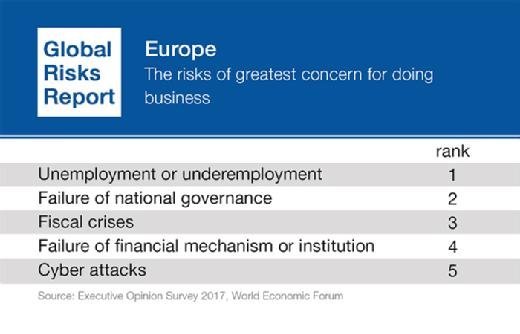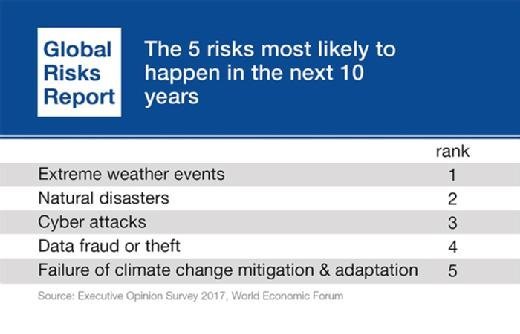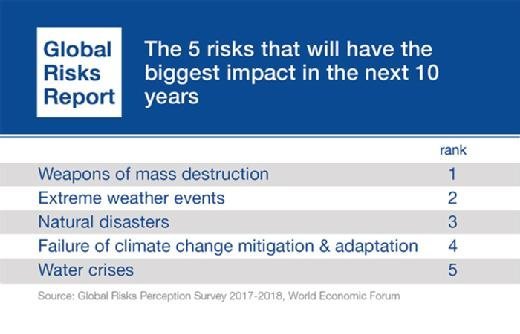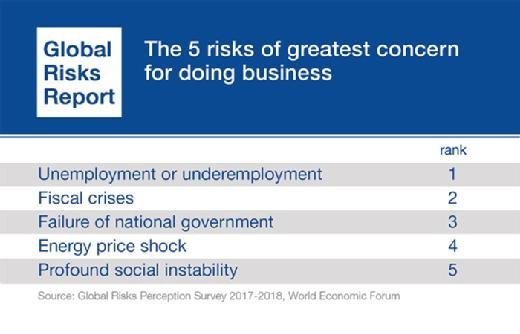
Fotimmz - Fotolia
Davos: Disintegration of the internet could create economic turmoil
Politicians and business leaders will discuss the risks posed by fake news, cyber attacks, and artificial intelligence to jobs, political stability and global security, at the World Economic Forum in Davos
The disintegration of the internet could lead to disruption of global economies over the next 10 years, the World Economic Forum (WEF) warned on 17 January 2018.
Pressures from cyber attacks, the growth of economic protectionism, and the desire for governments to introduce censorship could lead to the creation of internet “walled gardens”, which could disrupt commerce and damage societies.
The increasing reliance on governments, institutions and individuals on interconnected technology will be one of the key risks under discussion as business leaders, politicians, academics and non-government organisations assemble in Davos, Switzerland, from 23-26 January 2018.
A study released on 17 January 2018 by the WEF identifies the growing reliance on technology as one of the major risks facing global economies over the next 12 months.
Cyber attacks are growing in prominence and are ranked third in the list of most likely threats, while cyber dependency is ranked as the second-most significant driver shaping global risk over the next 10 years, according to The WEF’s Global risks report 2018.
Risk of ‘global systems breakdown’
The WEF said the prospect of strong economic growth this year presents leaders with an opportunity to address weaknesses in the complex systems that underpin economies, international relationships and the environment.
But it warned that, partly as a result of increasing political tensions and uncertainty, global risks will intensify, with experts predicting that political and economic tensions between major powers will worsen, leading to a heightened risk of armed confrontation.
“We must take seriously the risk of a global systems breakdown. Together, we have the resources and the new scientific and technical knowledge to prevent this,” said Klaus Schwab, founder and executive chairman of the WEF.

John Drzik, president of Global Risk and Digital at Marsh, and one of the contributors to the report said: “Geopolitical friction is contributing to a surge in the scale and sophistication of cyber attacks.
“At the same time, cyber exposure is growing as firms become more dependent on technology. While cyber risk management is improving, business and government need to invest far more in resilience efforts,” he said.
Interconnections create risk of ‘systemic shock’
The increasing interconnection between communication networks and electronic devices means that, in the future, temporary disruptions could be replaced by radical and potentially irreversible systemic shocks, the WEF said.
The internet of things (IoT), made up of devices and sensors connected to the internet, is predicted to grow from 8.4 billion devices to 20.4 billion by 2020. Coupled with the growth of cloud computing services, it is increasing the exposure of businesses and governments to cyber attack.
Large-scale distributed denial of service attacks (DDoS), once the exception, are now common place. In 2017, the average target for a DDoS attack was likely to be hit with a new attack 10 times each month.
People have become extremely adept at mitigating conventional risks, but are much less comfortable at dealing with complex risks, caused by the intersection of multiple causes and tipping points.
“When a risk cascades through a complex system, the danger is not of incremental damage but of a ‘runaway collapse’,” the report said.
Risk of fragmentation of the internet
Moves towards economic protectionism, censorship and repression by governments of their citizens, the loss of government power to global online companies, and damaging cross-border malware attacks could lead to the break up of the internet.
This, in turn, will disrupt the flow of information and transactions. The pace of technological change would slow, and human rights abuses would be likely to increase without the international scrutiny that the internet provides.
“Governments need to respond by working with technology companies to ensure that internet technologies develop in a politically sustainable way, and to ensure that advances in cyber security governance mitigate the risk of the internet fracturing,” the WEF said.
Cyber attacks will accelerate in 2018
Cyber risks became a growing concern during 2017, propelling cyber attacks and massive data fraud into the top five most likely global risks over the next 12 months.
The number of cyber breaches recorded by businesses has almost doubled in five years, from 68 breaches for each organisation in 2012 to 130 in 2017.
The financial cost of cyber attacks is also rising. One study put the cost of responding to cyber attacks last year at an average of £11.7m (UK) per company, and cyber attacks are expected to cost businesses $8tn (US) over the next five years.
The dark internet has once again become a thriving market for malware services and software, following a successful crackdown in 2012.
In 2016 alone, more than 360 million new variations of malware were released, with Trojans designed to steal malware available for as little as $500.

ransomware, which locks companies and individuals out of their data unless they agree to pay a ransom to release it, was responsible for a high percentage of the cost. It accounted for nearly 70% of malicious emails sent between July and September last year, affecting double the number of businesses than 2016.
The Wannacry attack affected 300,000 computers across 150 countries. It disrupted critical infrastructure across the world, including hospitals, government ministries, railways, banks, telecoms companies, energy providers, and car manufacturers.
The emergence of cyber space as an unregulated battlefield has created new ways for states to advance their interests, allowing interference in domestic or economic affairs that might be otherwise be considered acts of aggression.
The WEF first warned of the danger of spreading misinformation across social media five years ago, and since then the practice has surged.
According to one study, the top 20 false news stories out-performed the top 20 news stories from major news outlets, while other studies show that people have difficulty distinguishing the fake news from the genuine.
Fake news and propaganda
During the run-up to the US elections in 2016, fake news – much of it attributed to Russia – captured headlines around the world.
It emerged in September that that a Russian organisation had paid Facebook $100,000 to promote divisive political advertisements in the run-up to the US election.
An investigation by the US intelligence community claimed that Russia had been using the media outlets RT and Sputnik as vehicles to interfere in the US elections. Twitter subsequently banned the organisations.
Technology companies have responded with attempts to control disinformation. Facebook has started partnerships with fact-checking organisations, such as the News Integrity Initiative. Meanwhile, Twitter has announced policies to be more transparent about political advertising.
Attacks on critical infrastructure
The Wannacry outbreak highlighted the growing threat that malware attacks pose to critical national infrastructure.
Since an attack on the Ukraine’s power grid brought down 30 substations, and interrupted the power supply to 230,000 people, the number of infrastructure attacks has grown.
View global risks report 2018 with interactive graphics
In 2016, hackers stole $81m from the central bank of Bangladesh, following an attack on the SWIFT financial messaging network.
Last year saw spear phishing attacks, which attempted to install malware, directed against companies operating nuclear power plants in the US.
Risks of cyber war
Political disruption around the world has increased the risk of tensions between countries escalating into conflict.
The emergence of populist politics, and the move away from free trade to more protectionist policies, has heightened the risk of military conflict over the next 12 months.
Any conflict is likely to be accompanied by cyber attacks designed to disrupt critical national infrastructure.
The risks of misidentifying the source of an attack in cyber space are high, potentially leading to retaliation against the wrong nation state, and widening the conflict.

If a country’s critical infrastructure systems are compromised by a cyber attack, leading to disruption of essential services and loss of lives, the pressure to retaliate will build rapidly.
In addition, if a cyber weapon strays across borders into countries that were not targeted, the conflict is likely to escalate and could lead to the deployment of conventional forces.
Unlike cyber warfare, conventional warfare relies on agreed conventions, which slow the escalation of conflict.
“Familiar concepts – such as transparency, proportionality and non-proliferation – could be re-codified for cyber purposes,” said the report. “And perhaps classes of cyber weapons could be collectively prohibited, in the same way that biological and chemical weapons have been.”
Risk of artificial intelligence to employment
The unprecedented acceleration of technology over the past 10 years since the global economic crisis poses risks to social structure and the economy.
The original industrial revolution delivered huge improvements in welfare, but it led to prolonged social and economic turmoil, and set the scene for more revolutionary politics.

It is by no means certain that the fourth industrial revolution, driven by artificial intelligence (AI), will follow its predecessors by creating more and better jobs than it destroys.
Technological advances are likely to lead to increased unemployment in both advanced and developing countries, the WEF said, with developing countries likely to be hit the hardest.
“This generation enjoys unprecedented technological, scientific and financial resources, which we should use to chart towards a more equitable and inclusive future. And yet this is the first generation to take the world to the brink of a systems breakdown,” said Schwab, WEF founder and chairman.
How AI could choke the internet and devastate fish stocks
AI weeds could choke the internet
As the world becomes more interconnected, sudden and dramatic breakdowns become more likely.
One potential risk is that low-level artificial intelligence (AI) software, dubbed “weeds”, multiplies on the internet, slowly choking the available bandwidth.
As algorithms increase in sophistication, we could become more reliant on code that writes other code, creating the potential for explosive growth in software exploiting the internet.
“A trend towards reduced internet efficiency would undermine service delivery in countless businesses. It could hobble the internet of things,” said the report.
If the problem became significant enough, governments might chose to wall-off parts of the internet.
“Without a robust, enforceable, regulatory framework, there is a risk that humans will in effect be crowded out of the internet by the proliferation of AI,” it says.
AI drones devastate fish stocks
In another scenario, AI could automate illegal fishing, leading to a rapid collapse of fish stocks, which could have a cascading impact on marine ecology.
A large surge in the supply of illegal fish, caught by fishing drones, could distort food prices, leading to disruption for agriculture and the food production industries, and the loss of fishing communities.
Drone fishing could lead to diplomatic tensions, and retaliation from countries that believe their territorial waters had been illegally fished.
Read more on Hackers and cybercrime prevention
-
![]()
Davos 2025: Digital supply chains at risk as world faces two years of turbulence
-
![]()
Davos 2025: Misinformation and disinformation are most pressing risks, says World Economic Forum
-
![]()
CIOs will need a new strategy for AI risks and opportunities
-
![]()
Davos 2024: AI-generated disinformation poses threat to elections, says World Economic Forum







